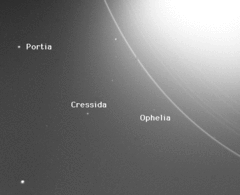天卫九
天卫九,又名克莱西达(英语:Cressida、希腊语:Χρησίδα),是环绕天王星运行的一颗卫星,于1986年由旅行者2号发现。[6]
 | |
| 发现 | |
|---|---|
| 发现者 | Stephen P. Synnott / 旅行者2号 |
| 发现日期 | 1986年1月9日 |
| 轨道参数 | |
| 二次轨道半径 | 61,766.730 ± 0.046 km[1] |
| 离心率 | 0.00036 ± 0.00011[1] |
| 轨道周期 | 0.463569601 ± 0.000000013 d[1] |
| 轨道倾角 | 0.006 ± 0.040°(相对天王星赤道)[1] |
| 隶属天体 | 天王星 |
| 物理特征 | |
| 大小 | 92 × 74 × 74 km[2] |
| 平均半径 | 39.8 ± 2 km[2][3][4] |
| 表面积 | ~20,000 km²[a] |
| 体积 | ~260,000 km³[a] |
| 质量 | ~3.4×1017 kg[a] |
| 平均密度 | ~1.3 g/cm³ (假定值)[3] |
| 表面重力 | ~0.013 m/s2[a] |
| ~0.034 km/s[a] | |
| 自转周期 | 同步[2] |
| 转轴倾角 | 零[2] |
| 反照率 | |
| 温度 | ~64 K[a] |
传统上所有天王星的英语名字都是以威廉·莎士比亚或亚历山大·蒲柏的作品中的人物的名称来命名的,这个传统从约翰·赫歇尔开始的一直延用至今。天卫九的英语名克莱西达是莎士比亚悲剧《脱爱勒斯与克莱西达》中,女主角特洛伊著名悲剧女英雄克莱西达的名字。
参考来源和注释 编辑
- 注释
- 参考来源
- ^ 1.0 1.1 1.2 1.3 Jacobson, R. A. The Orbits of the Inner Uranian Satellites From Hubble Space Telescope and Voyager 2 Observations. The Astronomical Journal. 1998, 115 (3): 1195–1199. Bibcode:1998AJ....115.1195J. doi:10.1086/300263.
- ^ 2.0 2.1 2.2 2.3 Karkoschka, Erich. Voyager's Eleventh Discovery of a Satellite of Uranus and Photometry and the First Size Measurements of Nine Satellites. Icarus. 2001, 151 (1): 69–77. Bibcode:2001Icar..151...69K. doi:10.1006/icar.2001.6597.
- ^ 3.0 3.1 3.2 Planetary Satellite Physical Parameters. JPL (Solar System Dynamics). 2008-10-24 [2008-12-12]. (原始内容存档于2020-05-21).
- ^ 4.0 4.1 Williams, Dr. David R. Uranian Satellite Fact Sheet. NASA (National Space Science Data Center). 2007-11-23 [2008-12-12]. (原始内容存档于2010-01-18).
- ^ Karkoschka, Erich. Comprehensive Photometry of the Rings and 16 Satellites of Uranus with the Hubble Space Telescope. Icarus. 2001, 151 (1): 51–68. Bibcode:2001Icar..151...51K. doi:10.1006/icar.2001.6596.
- ^ Smith, B. A. Satellites of Uranus. IAU Circular. 1986-01-16, 4164 [2011-10-29]. (原始内容存档于2011-11-05).
| 这是一篇与卫星相关的小作品。你可以通过编辑或修订扩充其内容。 |